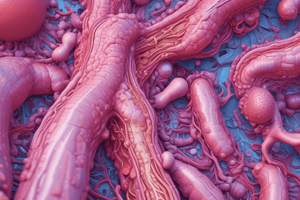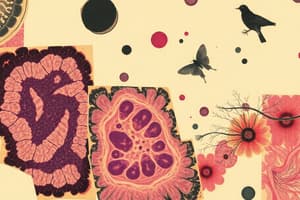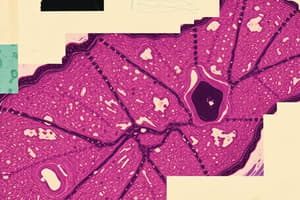Podcast
Questions and Answers
¿Cuál es la función principal del tejido adiposo unilocular en adultos?
¿Cuál es la función principal del tejido adiposo unilocular en adultos?
- Generar energía en forma de calor (correct)
- Almacenar nutrientes
- Producir hormonas
- Regenerar tejidos dañados
¿Dónde predomina el tejido adiposo en fetos y neonatos?
¿Dónde predomina el tejido adiposo en fetos y neonatos?
- Glándulas suprarrenales
- Región pélvico-inguinal
- Zona perirrenal
- Área del cuello y axilas (correct)
¿Qué característica distingue a los adipocitos del tejido adiposo unilocular?
¿Qué característica distingue a los adipocitos del tejido adiposo unilocular?
- Tienen múltiples núcleos
- Tienen un solo núcleo
- Contienen grandes grumos de glucógeno (correct)
- Carecen de vesículas
En adultos, ¿dónde se localiza típicamente el tejido adiposo unilocular?
En adultos, ¿dónde se localiza típicamente el tejido adiposo unilocular?
¿Cuál es la organización del tejido adiposo?
¿Cuál es la organización del tejido adiposo?
¿Qué tipo de nervios predominan en la inervación del tejido adiposo?
¿Qué tipo de nervios predominan en la inervación del tejido adiposo?
Cuál es la forma típica de los adipocitos?
Cuál es la forma típica de los adipocitos?
¿Cuál es el origen de las células que forman el tejido adiposo unilocular?
¿Cuál es el origen de las células que forman el tejido adiposo unilocular?
¿Cómo se describe la irrigación del tejido adiposo?
¿Cómo se describe la irrigación del tejido adiposo?
Cuál es el tamaño promedio de un adipocito?
Cuál es el tamaño promedio de un adipocito?
Qué tipo de organelos son escasos en los adipocitos?
Qué tipo de organelos son escasos en los adipocitos?
Qué sustancia ocupa casi toda la célula adiposa?
Qué sustancia ocupa casi toda la célula adiposa?
Cómo se recambian los lípidos en los adipocitos?
Cómo se recambian los lípidos en los adipocitos?
Qué tipo de inervación reciben los adipocitos?
Qué tipo de inervación reciben los adipocitos?
Qué tipo de receptores tienen los adipocitos?
Qué tipo de receptores tienen los adipocitos?
Cuál de las siguientes afirmaciones sobre la irrigación de los adipocitos es correcta?
Cuál de las siguientes afirmaciones sobre la irrigación de los adipocitos es correcta?
¿Cuál de las siguientes características se asocia al tejido adiposo multilocular?
¿Cuál de las siguientes características se asocia al tejido adiposo multilocular?
¿Qué color caracteriza principalmente al tejido adiposo multilocular?
¿Qué color caracteriza principalmente al tejido adiposo multilocular?
¿Cuál es el tamaño típico de las células del tejido adiposo multilocular?
¿Cuál es el tamaño típico de las células del tejido adiposo multilocular?
¿Qué característica presenta el núcleo de las células del tejido adiposo multilocular?
¿Qué característica presenta el núcleo de las células del tejido adiposo multilocular?
¿Qué sucede con el tejido adiposo multilocular durante la vida adulta?
¿Qué sucede con el tejido adiposo multilocular durante la vida adulta?
¿Cómo son las mitocondrias en el tejido adiposo multilocular?
¿Cómo son las mitocondrias en el tejido adiposo multilocular?
¿Cuál es la característica de las gotas de lípido en las células del tejido adiposo multilocular?
¿Cuál es la característica de las gotas de lípido en las células del tejido adiposo multilocular?
¿Qué le da el color característico al tejido adiposo multilocular?
¿Qué le da el color característico al tejido adiposo multilocular?
¿Dónde se localiza el tejido adiposo en el cuerpo humano?
¿Dónde se localiza el tejido adiposo en el cuerpo humano?
¿Qué estructura en los adipocitos multiloculares les permite generar calor?
¿Qué estructura en los adipocitos multiloculares les permite generar calor?
¿Cuál es una de las funciones del tejido adiposo además de almacenar grasa?
¿Cuál es una de las funciones del tejido adiposo además de almacenar grasa?
¿Qué glándulas secretan adipocinas?
¿Qué glándulas secretan adipocinas?
¿Qué sustancia se utiliza para teñir en un corte por congelación del tejido adiposo?
¿Qué sustancia se utiliza para teñir en un corte por congelación del tejido adiposo?
¿Qué tipo de adipocitos son responsables de la termogénesis en recién nacidos?
¿Qué tipo de adipocitos son responsables de la termogénesis en recién nacidos?
¿Cuál de las siguientes sustancias NO es considerada una adipocina?
¿Cuál de las siguientes sustancias NO es considerada una adipocina?
¿Qué sistema libera noradrenalina durante la termogénesis en tejidos adiposos?
¿Qué sistema libera noradrenalina durante la termogénesis en tejidos adiposos?
¿Cuál es la principal característica del tejido óseo?
¿Cuál es la principal característica del tejido óseo?
¿Qué mineral es el principal componente de la matriz del tejido óseo?
¿Qué mineral es el principal componente de la matriz del tejido óseo?
¿Cómo se clasifica el tejido óseo según su organización estructural?
¿Cómo se clasifica el tejido óseo según su organización estructural?
¿Qué función importante desempeña el tejido óseo en la homeostasis del organismo?
¿Qué función importante desempeña el tejido óseo en la homeostasis del organismo?
¿Qué parte del hueso corresponde a la estructura maciza?
¿Qué parte del hueso corresponde a la estructura maciza?
¿Cómo se describe la parte interna del hueso?
¿Cómo se describe la parte interna del hueso?
¿Qué estructura forma las trabéculas en el hueso esponjoso?
¿Qué estructura forma las trabéculas en el hueso esponjoso?
¿Qué parte de la organización del hueso no se observa en un corte longitudinal?
¿Qué parte de la organización del hueso no se observa en un corte longitudinal?
¿Cuál es la función principal del sistema nervioso en el organismo?
¿Cuál es la función principal del sistema nervioso en el organismo?
¿Qué tipo de inervación proporciona el sistema nervioso autónomo?
¿Qué tipo de inervación proporciona el sistema nervioso autónomo?
¿Cuáles son los dos tipos principales de células que componen el tejido nervioso?
¿Cuáles son los dos tipos principales de células que componen el tejido nervioso?
La remodelación interna del hueso en adultos está relacionada con qué fenómeno?
La remodelación interna del hueso en adultos está relacionada con qué fenómeno?
¿Cuál es la principal unidad funcional del sistema nervioso?
¿Cuál es la principal unidad funcional del sistema nervioso?
¿Qué componentes estructurales se encuentran entre los vasos sanguíneos y el tejido nervioso?
¿Qué componentes estructurales se encuentran entre los vasos sanguíneos y el tejido nervioso?
¿Cómo se dividen anatómicamente el sistema nervioso?
¿Cómo se dividen anatómicamente el sistema nervioso?
La red de comunicaciones de las neuronas se organiza principalmente para:
La red de comunicaciones de las neuronas se organiza principalmente para:
Flashcards
Multilocular Adipose Tissue
Multilocular Adipose Tissue
Brown or brown adipose tissue, characterized by numerous lipid droplets and mitochondria, and high metabolic activity.
Brown Adipose Tissue
Brown Adipose Tissue
A type of adipose tissue, important for heat production (thermogenesis), found primarily in newborns and infants.
Unilocular Adipose Tissue
Unilocular Adipose Tissue
A type of adipose tissue containing a large lipid droplet.
Mitochondria (in Brown Fat)
Mitochondria (in Brown Fat)
Signup and view all the flashcards
Lipid Droplets (Brown Fat)
Lipid Droplets (Brown Fat)
Signup and view all the flashcards
Thermogenesis
Thermogenesis
Signup and view all the flashcards
Cell Size (Brown Adipocytes)
Cell Size (Brown Adipocytes)
Signup and view all the flashcards
Color of Brown Adipose Tissue
Color of Brown Adipose Tissue
Signup and view all the flashcards
Adipose Tissue (Unilocular)
Adipose Tissue (Unilocular)
Signup and view all the flashcards
Adipocyte Origin
Adipocyte Origin
Signup and view all the flashcards
Adipose Tissue Location (Adults)
Adipose Tissue Location (Adults)
Signup and view all the flashcards
Adipose Tissue Distribution
Adipose Tissue Distribution
Signup and view all the flashcards
Adipose Tissue Function
Adipose Tissue Function
Signup and view all the flashcards
Adipose Tissue Support
Adipose Tissue Support
Signup and view all the flashcards
Glycogen Granules in Adipose Tissue
Glycogen Granules in Adipose Tissue
Signup and view all the flashcards
Adipose Tissue's Cellular Characteristics
Adipose Tissue's Cellular Characteristics
Signup and view all the flashcards
Adipocyte shape
Adipocyte shape
Signup and view all the flashcards
Adipocyte size range
Adipocyte size range
Signup and view all the flashcards
Adipocyte nucleus location
Adipocyte nucleus location
Signup and view all the flashcards
Adipocyte organelles
Adipocyte organelles
Signup and view all the flashcards
Lipid droplet structure
Lipid droplet structure
Signup and view all the flashcards
Lipid droplet turnover
Lipid droplet turnover
Signup and view all the flashcards
Adipocyte innervation
Adipocyte innervation
Signup and view all the flashcards
Adipocyte vascularity
Adipocyte vascularity
Signup and view all the flashcards
Adipose Tissue Location
Adipose Tissue Location
Signup and view all the flashcards
Multilocular Adipocytes
Multilocular Adipocytes
Signup and view all the flashcards
Adipocyte Function: Secretor
Adipocyte Function: Secretor
Signup and view all the flashcards
Thermogenesis (in Adipose Tissue)
Thermogenesis (in Adipose Tissue)
Signup and view all the flashcards
Brown Adipose Tissue Function
Brown Adipose Tissue Function
Signup and view all the flashcards
Mitochondria Role (in Brown Fat)
Mitochondria Role (in Brown Fat)
Signup and view all the flashcards
Noradrenaline's Role (in Brown Fat)
Noradrenaline's Role (in Brown Fat)
Signup and view all the flashcards
Newborn Heat Regulation
Newborn Heat Regulation
Signup and view all the flashcards
Compact Bone
Compact Bone
Signup and view all the flashcards
Spongy Bone
Spongy Bone
Signup and view all the flashcards
Bone Matrix
Bone Matrix
Signup and view all the flashcards
Hydroxyapatite
Hydroxyapatite
Signup and view all the flashcards
Bone Function
Bone Function
Signup and view all the flashcards
Trabeculae
Trabeculae
Signup and view all the flashcards
Bone Classification
Bone Classification
Signup and view all the flashcards
Bone Homeostasis
Bone Homeostasis
Signup and view all the flashcards
Bone Remodeling
Bone Remodeling
Signup and view all the flashcards
Havers' Canals
Havers' Canals
Signup and view all the flashcards
Systemic Nervous System
Systemic Nervous System
Signup and view all the flashcards
Central Nervous System (CNS)
Central Nervous System (CNS)
Signup and view all the flashcards
Peripheral Nervous System (PNS)
Peripheral Nervous System (PNS)
Signup and view all the flashcards
Neuron
Neuron
Signup and view all the flashcards
Nervous System Function
Nervous System Function
Signup and view all the flashcards
Nervous Tissue Composition
Nervous Tissue Composition
Signup and view all the flashcards
Study Notes
General Information
- Document is study notes regarding Histology and Pathology
- Course: Bases de Histología Médica I
- Topic: Tejidos Básicos
- Date: 22/05/2015
- Institution: Universidad Nacional Autónoma de México, Facultad de Estudios Superiores Iztacala
- Career: Médico Cirujano
Credits
- Information compiled by members of the Histology and Pathology department at UNAM.
- Figures and photographs are cited from their original sources.
- Copyright protected.
Tissues
- Four basic tissue types are presented.
Tissue Types
- Tejido Epitelial:
- Derived from all three germ layers.
- Covers body surfaces, lines cavities, form glands.
- Functions include protection, secretion, absorption, and transportation.
- Classified as simple and stratified, based on the number of cell layers.
- Further classified by cell shape (squamous, cuboidal, columnar).
- Tejido Conectivo:
- Connects other tissues.
- Provides support, structure, and connection.
- Characterized by cells and extracellular matrix.
- Includes various types like loose connective tissue, dense connective tissue, adipose tissue, cartilage, and blood.
- Tejido Muscular:
- Responsible for movement.
- Includes skeletal, smooth, and cardiac muscle types, each with unique structures and functions.
- Tejido Nervioso:
- Facilitates communication and control.
- Consists of neurons and glial cells.
- Controls and coordinates body functions through electrochemical signals.
Additional Subtopics
- Detailed descriptions of each tissue type, including their cellular components, functions, and locations in the body
- A detailed description on muscular tissue covering details on the different sections, and types.
- Detailed classifications for each tissue, including specific subtypes and examples.
- Detailed analysis of nervous and epithelial tissue classifications and structures.
Studying That Suits You
Use AI to generate personalized quizzes and flashcards to suit your learning preferences.




